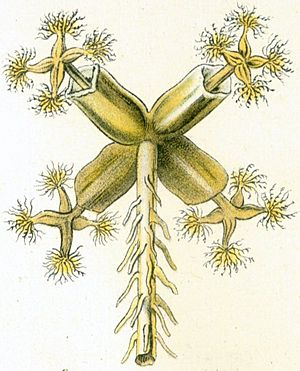Crescent-cup liverwort facts for kids

Quick facts for kids Lunularia |
|
|---|---|
 |
|
| Scientific classification | |
| Kingdom: | |
| Division: | |
| Class: |
Marchantiopsida
|
| Order: |
Marchantiales
Limpr. 1876
|
| Family: |
Lunulariaceae
H. Klinggr. 1858
|
| Genus: |
Lunularia
Adans.
|
| Species: |
L. cruciata
|
| Binomial name | |
| Lunularia cruciata (Linnaeus 1753) Dumortier 1822 ex Lindberg 1868
|
|
| Synonyms | |
|
|
Lunularia cruciata, also known as the crescent-cup liverwort, is a small, green plant. It belongs to a group of plants called liverworts. These are simple plants, similar to mosses.
Lunularia cruciata is the only species in its group, called the genus Lunularia. Its name comes from the Latin word luna, which means moon. This is because it has special moon-shaped cups on its surface.
Contents
Where It Lives
Lunularia cruciata is very common in western Europe. It naturally grows around the Mediterranean Sea.
It is also found in other parts of the world. For example, it grows "wild" in California. It is often seen as a weed in gardens and greenhouses in Australia.
- A scientist named Ella Orr Campbell thought that Lunularia arrived in New Zealand after 1867.
- In some places, like America, this plant only grows in a way that doesn't produce seeds.
How It Reproduces
Lunularia cruciata can make new plants in two main ways: without seeds (asexual) and with seeds (sexual).
Asexual Reproduction
The plant has small, crescent-shaped cups on its surface. Inside these cups are tiny, disc-shaped plant parts called gemmae.
- When rainwater splashes into these cups, the gemmae are easily washed out.
- If they land in a damp place, they can quickly grow into new Lunularia plants.
- This is why they are so good at spreading in places like greenhouses.
Sexual Reproduction
Even though it's great at asexual reproduction, Lunularia can also reproduce sexually.
- It forms special cross-shaped heads.
- These heads produce tiny plantlets that can grow into new plants.
- The main body of the Lunularia plant is called a thallus.
Special Features
Like many other liverworts, Lunularia produces a special chemical. This chemical is called lunularic acid. Scientists believe this acid can stop other liverworts from growing too much.
See also
 In Spanish: Lunularia cruciata para niños
In Spanish: Lunularia cruciata para niños

